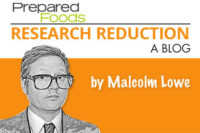Vegetarians at the Gates
Some 7% of consumers identify themselves as vegetarian; however, 36% indicate the use of meat alternatives.

“This data suggests that participation in the alternative meat category stretches far beyond necessity, and creates an opportunity for future growth based on the products’ ability to meet general consumer food interests, such as health, price, variety and convenience,” says Beth Bloom, food and drink analyst at Mintel. “The bottom line is that vegetarians and vegans aren’t the only people eating “fake” meat, meat eaters are also exploring this new found protein superpower.”
Health perception plays a large role in use of meat alternatives. One-third of consumers indicate using alternative meat products because they are healthy, higher than any other reason measured in the report. More than half (51%) of users believe they are healthier than real meat. In addition, some 31% are trying to reduce their meat consumption, and another 31% say they enjoy the taste of meat alternatives.
“While meat alternatives have the potential to meet a range of consumer needs, targeted health positioning has the potential to attract the specific attention of consumers,” adds Bloom.
Vegan claims on new products released in the meat alternative category surpassed vegetarian claims in 2011 to take the top spot. This, combined with the fact that the “no animal ingredients” claim saw the strongest growth from 2008-12 (200%), is an indication that consumers are becoming more extreme in their dietary habits.
The next leading claim to see strong growth is "GMO free" (155% growth, 2008-12). Given the interest in health among consumers of meat alternatives, products that can present a clean profile will be best positioned to attract the attention of shoppers.
On the other hand, not everyone is jumping on the meat-free bandwagon. The greatest percentage of nonusers (67%) indicate a preference for real meat, and 34% say they do not care for the taste of meat alternatives, while 20% do not like the texture.
“While, at one time, products in the category were seen as a substitute for meat consumption, the expansion of formats and flavors has allowed the category to grow beyond one of necessity to become one of desire. Product manufacturers and marketers have a chance to come out from behind the veil of “substitute” and stake a claim as a food option that stands on its own,” concludes Bloom.
Looking for a reprint of this article?
From high-res PDFs to custom plaques, order your copy today!




